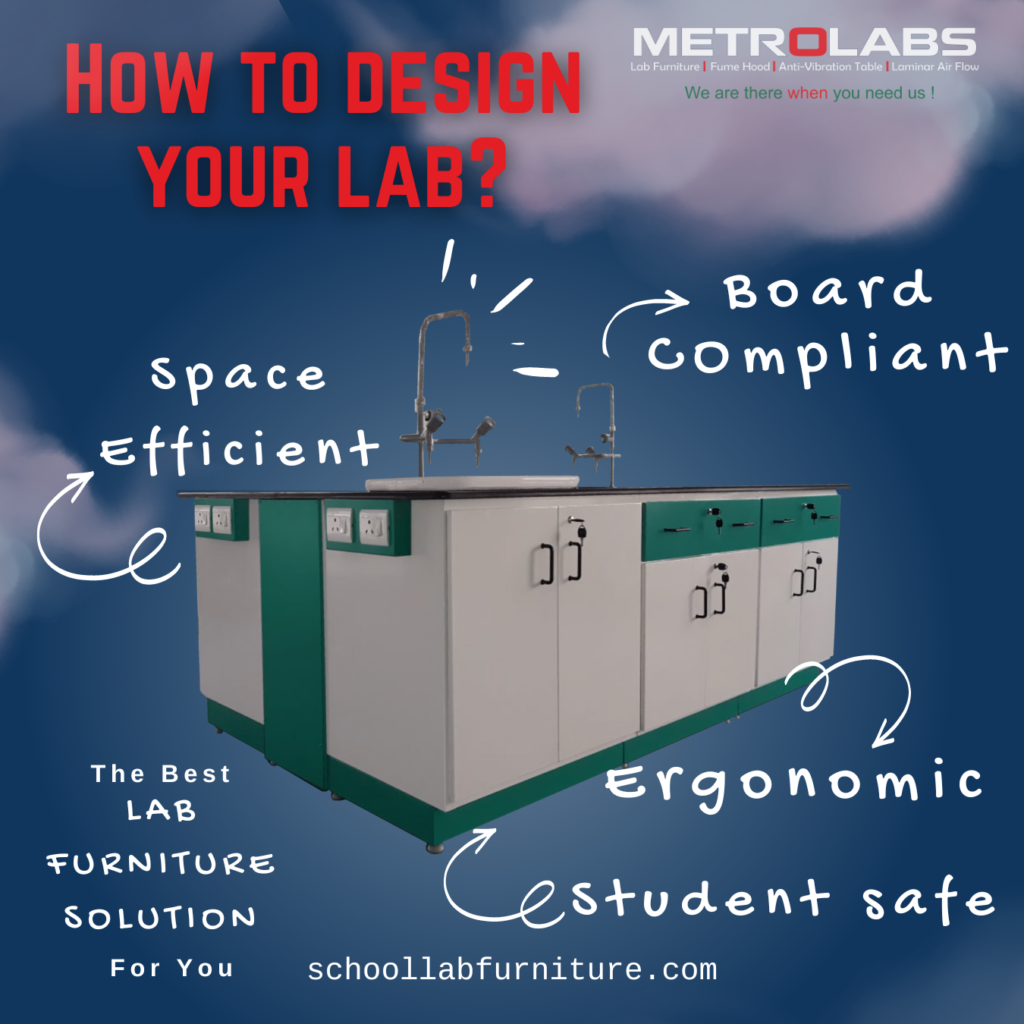How to design your lab
We Metrolabs, Design, Manufacture, Supply and Install School Lab Furniture – Pleasure to present you some of the guidelines to plan your laboratory

Plan your dream laboratory
We are there when you need us!
Designing Your Dream School Laboratory: Key Considerations for Teachers and Administrators
Are you a school teacher or administrator embarking on the exciting task of designing your school laboratory? In today's rapidly evolving educational landscape, making the right choices for your laboratory can be overwhelming. However, fret not! This article aims to provide you with a concise yet comprehensive guide to ensure a successful laboratory design process. Let's delve into the most critical points to consider and the key questions to ask yourself while making decisions for your laboratory.
1. Space Efficiency: Maximizing Utilization of Available Space.
One of the primary challenges in laboratory design is optimizing the use of the available space. The layout and arrangement of workstations, storage areas, and equipment to ensure efficient workflow must be considered. Opt for flexible and modular furniture that can be easily adjusted or rearranged to accommodate future renovation or changes in lab layout. Utilize vertical space with wall-mounted storage units, shelving, or cabinets to minimize clutter and enhance accessibility.
2. Board Compliance: Meeting Regulatory Standards
Compliance with the standards set by the school regulatory board is essential for the safety and functionality of your laboratory. Familiarize yourself with the specific guidelines and regulations related to laboratory design, equipment, ventilation, electrical systems, and more. The design must be ensured that it adheres to these standards, ensuring a safe and conducive learning environment for students and staff alike.
3. Ergonomics: Prioritizing Student Comfort and Teacher Visibility
Creating an ergonomic laboratory environment is crucial for both students and teachers. Consider the comfort and usability of laboratory furniture, such as chairs, tables, and workstations. Additionally, ensure that the laboratory layout allows for optimal visibility for teachers during demonstrations, enabling effective classroom management and supervision.
4. Safety First: Ensuring Student Well-being
Safety should be a top priority in any laboratory design. Evaluate the safety features and emergency procedures in your design. Are there clear egress pathways in case of emergencies? It must be ensured that the laboratory has sufficient fire exits, emergency showers, eyewash stations, and fire extinguishers, meeting the recommended standards for the average batch strength. Adequate ventilation systems, such as fume hoods, should be in place to protect students from harmful fumes or gases.
5. Storage and Organization: Streamlining Material Management
Efficient storage and organization systems are essential for a well-functioning laboratory. Incorporate ample storage space such as reagent racks and chemical storage cupboards for equipment, chemicals, and supplies, keeping them categorized and easily accessible. Ample cupboards, either floor-standing and wall-mounted must be incorporated for the storage of items such as PPEs like lab coats and goggles, student record notebooks, lab specimens, etc.
6. Material of Construction: Prioritizing Safety and Durability
Choosing the right materials for laboratory furniture is vital to ensure longevity, safety, and chemical resistance. Consider materials like Galvanized Iron (G.I) sheets for bodywork and granite for worktops. G.I. sheet bodywork is non-flammable and provides robust durability, while granite worktops offer resistance to chemical spills and wear. These materials not only contribute to the longevity of your laboratory furniture but also enhance safety and ease of maintenance.
7. Lighting and Acoustics: Enhancing the Learning Environment
Appropriate lighting and acoustics play a crucial role in creating a conducive learning environment. Aim for ample natural light to enhance visibility and create a positive ambiance. Complement natural lighting with well-designed artificial lighting that avoids harsh glare or shadows. Moreover, consider sound-absorbing materials or acoustic treatments to minimize noise disruptions, allowing students and teachers to focus better during experiments and discussions.
8. Accessibility: Catering to Diverse Needs
Design your laboratory with inclusivity in mind. Consider the needs of students with disabilities or special requirements. Ensure that the laboratory design complies with accessibility guidelines, providing suitable pathways, ramps, and adjustable equipment to accommodate students with physical limitations. Furthermore, incorporate clear signage, visual aids, and well-organized storage to facilitate easy navigation and access to materials for all students.
Designing your dream school laboratory involves careful consideration of multiple factors, ranging from space efficiency and regulatory compliance to student safety and ergonomic design. By addressing these key points and asking yourself the relevant questions, you can create a laboratory that fosters an optimal learning experience for students while providing a comfortable and functional space for teachers. Remember, a well-designed laboratory is not only an investment in education but also a gateway to inspire future generations of scientists, innovators, and thinkers.
CBSE Notifications and Circulars
- Safety in School Science Laboratories
- Physical facilities in the schools – provision thereof
- Safety in schools of children in schools – Reg.
- Compendium of CBSE Circulars Volume-I
- Compendium of CBSE Circulars Volume-II
- Science Exhibition 22 – 2023
- list of science kit items for upper primary stage
- Composite Lab -Essential Standard Operating Procedure (SOP) Required for Affiliation with CBSE
- Chemistry Lab -Essential Standard Operating Procedure (SOP) Required for Affiliation with CBSE
- Physics Lab -Essential Standard Operating Procedure (SOP) Required for Affiliation with CBSE
- Biology Lab -Essential Standard Operating Procedure (SOP) Required for Affiliation with CBSE
- Mathematics Lab -Essential Standard Operating Procedure (SOP) Required for Affiliation with CBSE
- Computer Science Lab -Essential Standard Operating Procedure (SOP) Required for Affiliation with CBSE
© 2023 All Rights Reserved.

